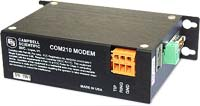This product is not available for new orders. We recommend ordering: COM220.

| Services Available | |
|---|---|
| Repair | No |
| Calibration | No |
| Free Support | No |
Visão Geral
The COM210 modem enabled communications between a computer and a Campbell data logger via a public switched telephone network. A Hayes-compatible modem was required at the base-station computer while a COM210 was connected to the data logger at the field site. The COM210's wide operating temperature range and minimal power requirements made it ideal for use at remote sites.
Leia maisimagens

Produtos Relacionados
Descrição Técnica
The COM210 modem enabled communications between a computer and a Campbell data logger via a public switched telephone network. A Hayes-compatible modem was required at the base-station computer while a COM210 was connected to the data logger at the field site. The COM210's wide operating temperature range and minimal power requirements made it ideal for use at remote sites.
Note
Historically, the 10704 Power Adapter was available for connecting the COM210 to the CR500 with s/n 1764 or lower, and the CR10 with the silver or 8032 black wiring panel. The adapter applied a constant 12 V to the COM210's serial I/O. This power adapter is no longer available.
Compatibilidade
Please note: The following shows notable compatibility information. It is not a comprehensive list of all compatible products.
Data Loggers
| Product | Compatible | Note |
|---|---|---|
| 21X (retired) | ||
| CR10 (retired) | Not compatible with the CR10's silver or 8032 black wiring panel. Originally the 10704 Power Adapter was used to connect the COM210 to these wiring panels. The 10704 adapter is no longer available. | |
| CR1000 (retired) | ||
| CR10X (retired) | ||
| CR200X (retired) | ||
| CR206X (retired) | ||
| CR211X (retired) | ||
| CR216X (retired) | ||
| CR23X (retired) | ||
| CR295X (retired) | ||
| CR3000 (retired) | ||
| CR500 (retired) | ||
| CR5000 (retired) | ||
| CR510 (retired) | ||
| CR800 (retired) | ||
| CR850 (retired) | ||
| CR9000 (retired) | ||
| CR9000X (retired) | Although the CR9000X is compatible, the COM210 does not support its fastest communication rates, and is therefore not practical for most of its applications. |
Additional Compatibility Information
Power Considerations
The COM210 consumed 120 microAmps quiescent, 160 mA active (max). The data logger's power supply was sufficient for most applications.
Cabling
Data Logger-to-COM210
An SC12 cable was provided for this purpose.
Phone Line-to-COM210
Typically, a length of phone line was run from the telephone company's junction box to the COM210s surge protector, and then to the Ground, Tip, and Ring terminals on the COM210. Alternately, if adequate surge protection was provided by the telephone company and the junction box supports it, a length of telephone wire with RJ11C connectors (#2365) could be run directly from the junction box to the socket on the COM210.
Surge Protection
If the local telephone company did not provide surge protection, either the 6362 or 4330 surge protector needed to be used. See "Ordering Info" tab for more information.
Enclosures
The COM210 required a desiccated, non-condensing environment; a Campbell Scientific enclosure was recommended. Grommets and screws were provided to attach the COM210 to the backplate of our enclosures.
Software
LoggerNet and PC400 software are compatible with the COM210. Both of these software packages provide automated error-checking or user-initiated contacts. LoggerNet also supports scheduled contact times. Our software can run unattended allowing the user to take advantage of lower off-hour telephone rates.
Especificações
| Standards | Bell 212A, CCITT V.22, V.32bis |
| FCC Registration | B9QUSA-31402-MM-T |
| Operating Voltage | 12 V |
| Active Current Drain | 160 mA |
| Quiescent Current Drain | 120 μA |
| Baud Rate | 1200, 4800, 9600 bps |
| Operation | Full-duplex over standard analog phone lines |
| Standard Operating Temperature Range | -25° to +50°C |
| Extended Operating Temperature Range | -55° to +85°C |
| Dimensions | 16.0 x 4.3 x 9.1 cm (6.3 x 1.7 x 3.6 in.) with mounts |
| Weight | 272 g (10 oz) |
Documentos Relacionados
Lâminas do produto
Manuais
Perguntas Frequentes Relacionadas
Number of FAQs related to COM210: 2
-
Yes. We refer to this type of setup as a phone-to-RF base. At the phone-to-RF base, the following are needed: a CS I/O null-modem port (CH100 with A100), a power supply (BP12 or BP24), a radio (RF401), and a phone modem (COM220). Other items are likely needed, such as an enclosure (ENC12/14) and mounting hardware. The phone-to-RF base cannot include a data logger. For details, see Appendix I of the RF401 Instruction Manual.
-
There are several pieces of equipment that are needed to make this work correctly: an installed version of LoggerNet 2.1 or greater, the COM200/COM210, an SC532A, an RS-232 cable, and an SC12 cable.
The first step is to connect everything together correctly. Use the SC12 cable to connect the SC532A to the COM200/COM210 modem. Use the RS-232 cable to connect the other side of the SC532A to the COM port on the computer. Make sure that the computer is powered on and that LoggerNet is up on the screen.
In LoggerNet, select Setup ComPort - Generic Modem 1 - Generic Modem 2. Set the baud rate to 9600 baud. On Generic Modem 1, set RTS low and DTR high.
Using the terminal emulator from the Tools menu of LoggerNet, select Generic Modem 2, and select Open Port. Type AT. The modem will respond with a zero indicating communications are established.
Estudos de Caso
The West Texas Mesonet (WTM) project was initiated by Texas Tech University in 1999 to......Leia mais
The past few years have seen a scramble within the power industry to use more......Leia mais



